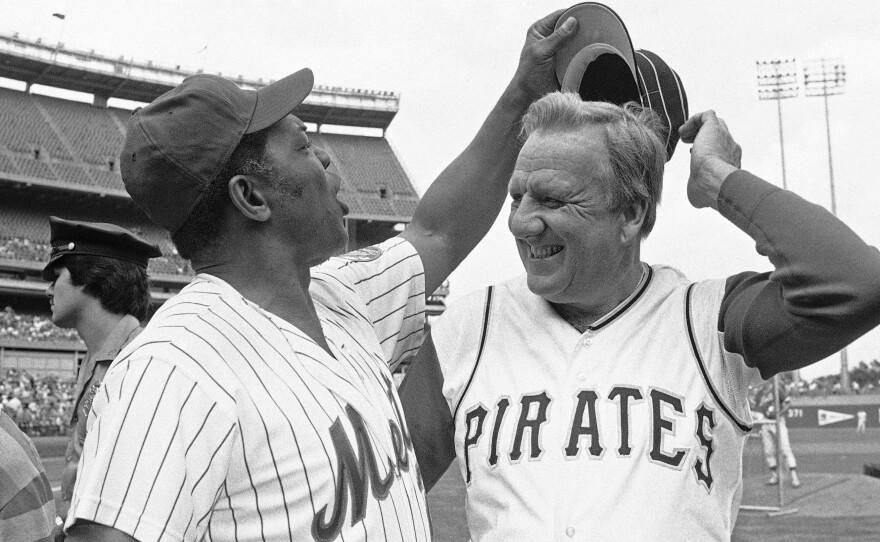
Ralph Kiner, a home run-hitting Hall of Famer who starred for the Pittsburgh Pirates and later helped define the New York Mets' broadcasts, has died at 91. He was a frequent all-star who later became a favorite of Mets fans and players.
Outside of sports fans' circles, Kiner's name might not ring a bell. But as the New York Daily News reports, he was most definitely a "somebody" for nearly all of his long life:
"It is hard to imagine anyone having lived a more dream life than Kiner, who grew up in Alhambra, Calif., a suburb of Los Angeles, fulfilled his childhood ambition of being a major league baseball player, won a record seven straight National League home run titles to get himself elected to the Hall of Fame and, along the way, was golfing pals with Hollywood legends Bing Crosby, Frank Sinatra, Bob Hope and Jack Benny, dated movie stars Janet Leigh and Elizabeth Taylor, and, finally, became one of the most beloved New York sports figures as Mets broadcaster from their 1962 inception until 2006 when he finally had his workload reduced to cameo TV appearances."
Kiner died of natural causes early Thursday at his home in Rancho Mirage, Calif., according to the Baseball Hall of Fame.
In the 1940s, Kiner's big-league career was delayed by a stint in the Navy, the Daily News reports. He returned to baseball after World War II ended in 1945 and went on to win the National League home run title in 1946, his rookie season.
After joining the Pirates, Kiner hit more than 40 home runs in five different seasons. In one of his strongest years, 1949, he hit 54 homers with just 61 strikeouts, as he batted in 127 runs and drew 117 walks.
"As one of baseball's most prolific power hitters for a decade, Ralph struck fear into the hearts of the best pitchers of Baseball's Golden Era despite his easy-going nature, disarming humility and movie-star smile," said Jeff Idelson, president of the National Baseball Hall of Fame and Museum.
"His engaging personality and profound knowledge of the game turned him into a living room companion for millions of New York Mets fans who adored his game broadcasts and later 'Kiner's Korner' for more than half a century," Idelson said. "He was as comfortable hanging out in Palm Springs with his friend Bob Hope as he was hitting in front of Hank Greenberg at Forbes Field."
Kiner met Greenberg, his friend and mentor, in Pittsburgh. As the city's Post-Gazette reports, Kiner came along at a good time for the city:
"Kiner arrived in Pittsburgh in 1946, when the city was returning to normalcy after World War II and searching for a hero. He fit the mold. Handsome, clean-cut, bright, personable and able to deliver the most exciting sports moment with astonishing frequency, Kiner shone like no Pirate before or after him.
"He led the National League in home runs his first seven seasons, 1946 through 1952. He was the idol of the town and that only increased when he courted and married, in 1951, Nancy Chaffee, a glamorous and world-famous tennis champion."
Years after he retired, Kiner endeared himself to New York Mets players and fans, sharing enigmatic moments during games and a show featuring his chats with athletes.
"Someone asked me how come I signed up with the Mets [as a broadcaster], since they weren't going to win many games," Kiner later said. "I said: 'I've got a lot of experience with losing.' "
From the AP:
" 'Kiner's Korner' was a delight for players and fans alike, where stars would join Kiner for postgame chats. Known for malaprops -- he once even forgot his own name on air -- he took the occasional slips in stride.
" 'He was a jewel,' Hall of Famer Tom Seaver said. 'He loved the game of baseball. He loved to see it played correctly and smartly. He loved to talk baseball. He deeply understood the game, especially hitting.' "
As The New York Times reports, Kiner once "declared that 'if Casey Stengel were still alive he'd be spinning in his grave,' " and described home runs with "the trademark call, 'Going, going, gone, goodbye!' "
Copyright 2014 NPR. To see more, visit www.npr.org.






